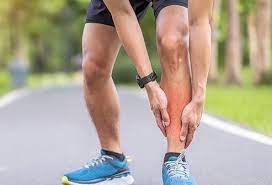The Mirror's Health , Lifestyle and Fashion

Dealing with shin splints
The changes may place a lot of stress on your leg muscles and bones and your body is forced to adapt to the stress which may cause shin splints to develop.
Advertisement
Shin splints is an umbrella term for various conditions which causes pain in front of your shin/leg and is frequently increased by exercise. It is also often used to describe lower leg pain and it’s associated with an alteration in running techniques, footwear or abrupt changes in training levels.
If you experience pain in your lower leg as you run, then it’s essential to address it early to prevent prolonged strain to your leg, which can lead to more serious conditions.
The lower leg consists of two long bones, many muscles and tough cords. When these muscles are overworked, they pull on the bones of the leg and cause the pain associated with shin splints.
The pain caused by shin splints may be a result of fatigue and stress to the muscles and tough cords which are attached to the leg bones. This excessive stress may cause the tough cords connecting the muscles to the bones to be partially torn away from the bone.
What are the risk factors for shin splints?
The muscles on the front portion of your lower legs are usually challenged by the repetitive stress that running places on the body coupled with tightness in the calf muscles which many runners experience pave way for Shin Splints to develop.
The stress placed on the muscles increases the strain where the muscles attach to the leg bones and Shin splints result when the strain is excessive such that the muscles are not able to bear it.
Other risk factors include;
1. Training errors
The condition occurs when there is a lot of running or weight-bearing activity and the impact is excessive. Usually, the abrupt force associated with repetitive activity causes the muscles and tough cords to become fatigued and overloaded, hence are unable to absorb the force generated in the leg.
Causes for training errors include:
• Training on uneven surfaces
• Sudden change in terrain - uphill or downhill running
• Training on hard surfaces
• A sudden increase in your exercise intensity or duration
• Exercising after a long break
• Training in worn out or ill-fitting shoes
2. Structural inefficiencies in the leg
The major inefficiency associated with the condition is flat feet. Individuals with flat feet usually have excessive rolling in the foot and the continuous turning causes the bones of the leg to turn awkwardly, stretching the muscles and tough cords in the leg.
Other causes of inefficiencies include:
• Poor training techniques
• Tightness and stiffness in the muscles of the lower leg
• Poor placement of the foot on the ground when running
What are the signs and symptoms?
Individuals with this condition experience pain and discomfort all over the area along the lower aspect of the lower leg. Depending on the stage of injury, pain may occur before each run or maybe sustained throughout the run afterwards during the rest of the day.
Some individuals may also feel a dull aching pain in the front of the leg that decreases with rest and the involved area of the leg maybe swollen. As the condition advances, the pain gets worse with activity and the individual may be in constant pain and a longer rest period is required to alleviate symptoms.
How is it diagnosed?
A physical examination is conducted to check for swelling, tenderness/pain and limitations in range of motion in the lower leg and foot.
The individual also recounts any previous leg injuries and which activities were being undertaken at the time the present injury occurred. The individual may also be asked to perform a series of movements with the leg and may have to take an X-ray to assist in the diagnosis.
The shin bone can be found in the front part of the lower leg. This part of the body is usually under continuous stress and strain whenever you walk, jump and run.
The immediate management involves a reduction in the pain and once this is achieved, subsequent aims are to regain and improve strength, endurance in the leg muscles and flexibility in the leg joints. Management also involves the following:
• Gait and footwear correction
When you have Shin Splints it may be due to a number of factors including how you usually walk or run. The identification of this is vital to prevent recurrence as the inappropriate way of walking may cause a great deal of stress in the leg each day.
Your physiotherapist will assist you to correct your gait pattern and also make recommendations of appropriate footwear to use daily.
• Muscle stretches and strengthening
There are specific muscles attached to the shin bone which must be adequately stretched daily before engaging in any form of intense activity.
Management, therefore, includes various stretches of the foot and leg muscles to maintain flexibility. Strengthening exercises also assists the muscles to carry out activities successfully without injury.
• Alterations in activities
You may not be able to continue training fully as before when you are injured and insisting on performing those same activities may cause further injury during your rehabilitation.
There are equally good activities which will also condition your muscles and prepare you for training such as cycling and swimming. These activities assist in relieving stress in your leg muscles so that they can heal properly.
• Range of motion exercises
Physiotherapy management includes regular movement of the ankle, knee and hip joints to improve blood circulation, reduce swelling and tightness in the leg muscles.
• Foot arch support
Some individuals may have flat feet i.e. Loss of the foot arch and this may predispose them to have Shin Splints. Such individuals need to obtain appropriate foot arch supports to insert in their footwear in order to have better placement of their feet each time they walk or run.
The foot arch support provides the needed amount of support for such individuals.
Therapeutic exercises
There are a variety of stretches to help maintain the flexibility of your leg muscles. These include:
Calf stretches
• Stand upright and place the ball of your affected foot onto a step or raised object. Bend your knee and slowly lean forward while allowing your heel to drop downwards.
Maintain the stretch for a few seconds and relax. Repeat as often as you can daily.
• Stand facing a wall with both hands on the wall - shoulder level. Keep your affected leg back with your heel on the floor and your other leg forward with your knee bent.
• Gently lean into the wall until you feel a stretch in you calf muscle of your affected leg and hold the position briefly. Relax and repeat as often as you can tolerate throughout the day.
Towel stretch
Sit on the bed or ground with your back against the wall and both legs stretched out in front of you.
Wrap a towel or cloth around the ball of your injured foot and gently pull the towel or cloth towards your body whiles keeping your knee straight.
Maintain the stretch for a few seconds and relax. Repeat often throughout the day.
Minimising risk of Shin Splints
Prevention is always better than cure. You can prevent or minimise Shin Splints by implementing simple measures.
• Many leg problems arise due to leg movement inefficiencies, hence you need to ensure that your running shoes are in good condition because this may cause you not to run correctly. Good footwear goes a long way to help you minimise leg problems.
• Avoid running on very hard surfaces such as the pavement or the sidewalk. Instead train in the grass to minimise the impact produced through your legs.
• Always warm up to prepare your muscles for activity. Without an appropriate warm-up, your muscles and joints become tight and stiff and make them prone to injury.
• Flexibility is also vital to prevent injuries. When your muscles are flexible, you are able to move better. Ensure that you adequately stretch your calves to maintain their flexibility and reduce tightness.
• You also need to strengthen and condition your leg muscles. Weakness in your leg muscles also make you prone to injuries as you train so to prevent Shin Splints, you need to include strengthening programmes in your training.




